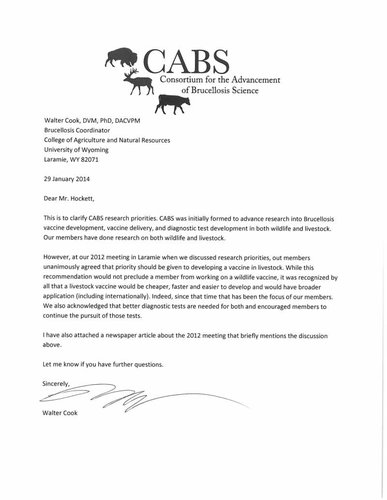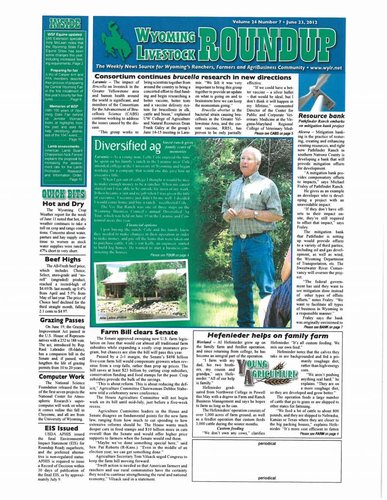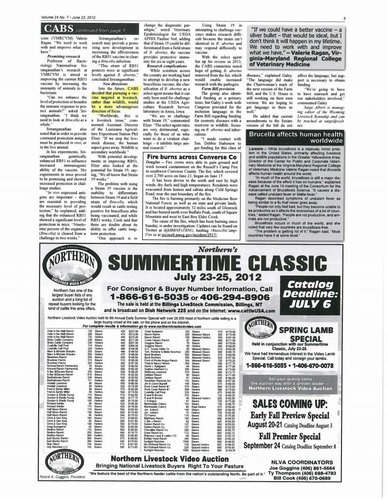katqanna
Well-known member
Rob Chaneys article in the Missoulian came out.
Farm bill provision worries wildlife advocates; brucellosis threat could lead to elk slaughter
He misquoted me being an elk hunter. I have not had that pleasure yet here in Montana with the ripped rotator cuff and muscles, I did process my husbands (now ex), though he lied about shooting it (I helped him choose the rifle and I bought the bullets. The one I pulled out was not the same caliber of the ones I bought.). He was trying to impress me. He had not hunted before.
At any rate, As I told Rob, I had been following the money trail when I decided to pull up the Farm Bill this mid Nov. to see if the same funnels were in it that I had found in previous bills. It was, in addition to another section 7104 dealing with APHIS VS grants which is part of the brucellosis industry - the academic papers mostly geared towards eradication of brucellosis in wildlife. So I let some people know about this and kept digging into it. Contacting the legislators seemed kind of pointless, since they ( 3 GYA states federal senators and reps, a bipartisan effort) have been sponsoring these efforts all the way back to 2007 that I have looked. I doubt they would actually go against their own sponsorship just because some of us are pissed about what their plans for our wildlife are.
Not so sure RMEF thought this was just for livestock, "RMEF spokesman Mark Holyoak said his group’s understanding was 'the funding will develop a better vaccination for livestock' as a way to avoid the slaughter of wildlife to prevent spread of the disease." Not trying to dis RMEF, but there are other factors going on.
While all roads lead to APHIS, as far as whose driving this tank, of the 3 GYA states involvement, Wyoming seems to be the epicenter of all this activity, especially multiple organizations created to continue driving this brucellosis eradication in wildlife. In fact Montana's own FWP website, concerning elk brucellosis working group, links to Wyomings Game & Fish Brucellosis page, where they showcase the many brucellosis management plans for each area.
There is a CABS program, out of Wyoming, where this Farm Bill section came from. The Consortium for the Advancement of Brucellosis Science. From their website, they state on their fact sheet, The ultimate goal of the CABS is to conduct stakeholder outreach and partner with state and federal policy makers to fund research initiatives that will work toward successful brucellosis disease control and prevention in free-ranging bison and elk in the Greater Yellowstone Area (GYA). The GYA is the last remaining reservoir of brucellosis in the United States." They link to documents from APHIS that I have on my APHIS Brucellosis Eradication Agenda page.
I will get these pages uploaded right now, then put the links back here, so that y'all can see for yourselves. As I see it, there is no way RMEF could not have known CABS was being used for wildlife vaccination. I will explain why after I load the pages.
Farm bill provision worries wildlife advocates; brucellosis threat could lead to elk slaughter
He misquoted me being an elk hunter. I have not had that pleasure yet here in Montana with the ripped rotator cuff and muscles, I did process my husbands (now ex), though he lied about shooting it (I helped him choose the rifle and I bought the bullets. The one I pulled out was not the same caliber of the ones I bought.). He was trying to impress me. He had not hunted before.
At any rate, As I told Rob, I had been following the money trail when I decided to pull up the Farm Bill this mid Nov. to see if the same funnels were in it that I had found in previous bills. It was, in addition to another section 7104 dealing with APHIS VS grants which is part of the brucellosis industry - the academic papers mostly geared towards eradication of brucellosis in wildlife. So I let some people know about this and kept digging into it. Contacting the legislators seemed kind of pointless, since they ( 3 GYA states federal senators and reps, a bipartisan effort) have been sponsoring these efforts all the way back to 2007 that I have looked. I doubt they would actually go against their own sponsorship just because some of us are pissed about what their plans for our wildlife are.
Not so sure RMEF thought this was just for livestock, "RMEF spokesman Mark Holyoak said his group’s understanding was 'the funding will develop a better vaccination for livestock' as a way to avoid the slaughter of wildlife to prevent spread of the disease." Not trying to dis RMEF, but there are other factors going on.
While all roads lead to APHIS, as far as whose driving this tank, of the 3 GYA states involvement, Wyoming seems to be the epicenter of all this activity, especially multiple organizations created to continue driving this brucellosis eradication in wildlife. In fact Montana's own FWP website, concerning elk brucellosis working group, links to Wyomings Game & Fish Brucellosis page, where they showcase the many brucellosis management plans for each area.
There is a CABS program, out of Wyoming, where this Farm Bill section came from. The Consortium for the Advancement of Brucellosis Science. From their website, they state on their fact sheet, The ultimate goal of the CABS is to conduct stakeholder outreach and partner with state and federal policy makers to fund research initiatives that will work toward successful brucellosis disease control and prevention in free-ranging bison and elk in the Greater Yellowstone Area (GYA). The GYA is the last remaining reservoir of brucellosis in the United States." They link to documents from APHIS that I have on my APHIS Brucellosis Eradication Agenda page.
I will get these pages uploaded right now, then put the links back here, so that y'all can see for yourselves. As I see it, there is no way RMEF could not have known CABS was being used for wildlife vaccination. I will explain why after I load the pages.
Last edited:







